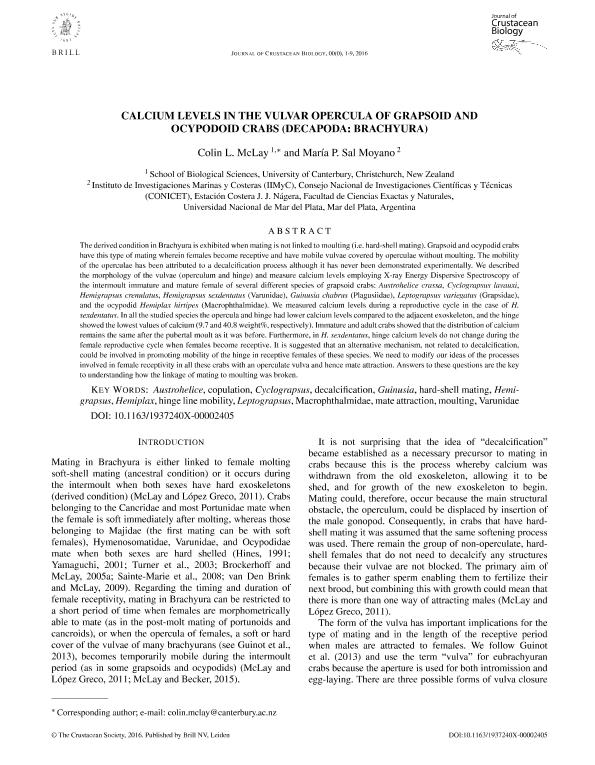Artículo
Calcium levels in the vulvar opercula of grapsoid and ocypodoid crabs (Decapoda: Brachyura)
Fecha de publicación:
03/2016
Editorial:
Crustacean Society
Revista:
Journal of Crustacean Biology
ISSN:
0278-0372
e-ISSN:
1937-240X
Idioma:
Inglés
Tipo de recurso:
Artículo publicado
Clasificación temática:
Resumen
The derived condition in Brachyura is exhibited when mating is not linked to moulting (i.e. hard-shell mating). Grapsoid and ocypodid crabs have this type of mating wherein females become receptive and have mobile vulvae covered by operculae without moulting. The mobility of the operculae has been attributed to a decalcification process although it has never been demonstrated experimentally. We described the morphology of the vulvae (operculum and hinge) and measure calcium levels employing X-ray Energy Dispersive Spectroscopy of the intermoult immature and mature female of several different species of grapsoid crabs: Austrohelice crassa, Cyclograpsus lavauxi, Hemigrapsus crenulatus, Hemigrapsus sexdentatus (Varunidae), Guinusia chabrus (Plagusiidae), Leptograpsus variegatus (Grapsidae), and the ocypodid Hemiplax hirtipes (Macrophthalmidae). We measured calcium levels during a reproductive cycle in the case of H. sexdentatus. In all the studied species the opercula and hinge had lower calcium levels compared to the adjacent exoskeleton, and the hinge showed the lowest values of calcium (9.7 and 40.8 weight%, respectively). Immature and adult crabs showed that the distribution of calcium remains the same after the pubertal moult as it was before. Furthermore, in H. sexdentatus, hinge calcium levels do not change during the female reproductive cycle when females become receptive. It is suggested that an alternative mechanism, not related to decalcification, could be involved in promoting mobility of the hinge in receptive females of these species. We need to modify our ideas of the processes involved in female receptivity in all these crabs with an operculate vulva and hence mate attraction. Answers to these questions are the key to understanding how the linkage of mating to moulting was broken.
Archivos asociados
Licencia
Identificadores
Colecciones
Articulos(IIMYC)
Articulos de INSTITUTO DE INVESTIGACIONES MARINAS Y COSTERAS
Articulos de INSTITUTO DE INVESTIGACIONES MARINAS Y COSTERAS
Citación
McLay, Colin L.; Sal Moyano, María Paz; Calcium levels in the vulvar opercula of grapsoid and ocypodoid crabs (Decapoda: Brachyura); Crustacean Society; Journal of Crustacean Biology; 36; 2; 3-2016; 220-228
Compartir
Altmétricas




